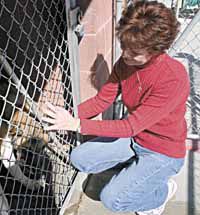| Animal control director Carol Logston visits with Kira, a dog ready to be adopted from the county’s shelter. |
Carol Logston assumed the position as the county’s animal control director on Jan. 18.
Within a few weeks, a parvo epidemic raged through the kennels at the shelter and Logston was faced with the possibility of euthanizing dozens of animals. The fact that people kept bringing more dogs to the facility compounded the problem.
With the help of the local media and citizens, the staff, began sorting out the mess to keep as many animals alive as possible.
“Through that entire thing, we didn’t lose one animal,” stated Logston on Tuesday. “Many think parvo is an automatic death sentence, but it isn’t.”
According to Working Dogs website, parvo is a viral disease. It affects puppies more frequently than adult dogs. The virus grows in rapidly dividing cells. The intestinal lining has the biggest concentration of rapidly dividing cells in a puppy’s body. The virus attacks and kills the cells, causing diarrhea, depression and suppression of white blood cells. In young puppies, parvo can infect the heart muscle and lead to death.
“We had to act quickly,” said Logston. “We called the local radio stations and they began to announce that we would not be able to take animals until we could lift a quarantine I had to impose on the facility.”
Logston said the staff also contacted people who had adopted dogs and told them to go to the veterinarian to get treatment for the animals.
The disease was discovered when No More Homeless Pets took some puppies from the center to the Wasatch Front to be adopted. The group contacted Logston when some of the some the animals became sick.
“We were using two kinds of antibiotics to control the problem,” explained Logston. “It was a heart wrenching, but rewarding experience because we didn’t lose anybody.”
Before coming to work for the county, Logston worked with the Humane Society for about 10 years, some of the time trying to find animals that were being abused.
“When I was doing that, we would find a dog without shelter or water and all we could do was suggest that owners take better care of them,” said the director. “Now I can have a real effect on what happens to them.”
As a child, Logston continually brought home stray animals and a playhouse built by her mother turned into what the family called the “cat house.”
“I always had respect and a closeness for animals,” noted the director. “That’s what makes this job hard sometimes. Since I have been here we have had to put down 14 animals, all of them because of illness. Death isn’t always the enemy.”
Logston hopes that, someday, the county’s animal shelter can be a no kill facility, where every animal that comes in is sent out to a happy home. She believes that can happen, especially with the number of people who care about animals in the community.
“During the parvo epidemic, the community really stepped up and helped us,” noted Logston. “Many people took in strays while we were closed and many of the police agencies worked very hard to find owners of animals so they didn’t have to bring the problems to us. All I can say there are many angels out there who helped out when we needed support.”

